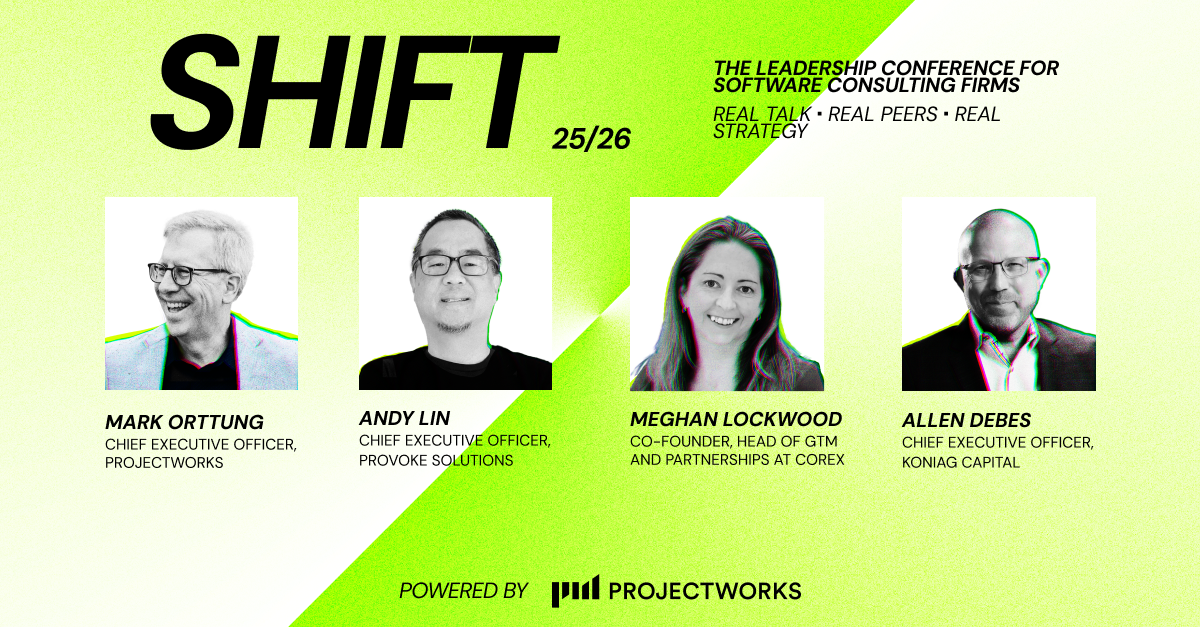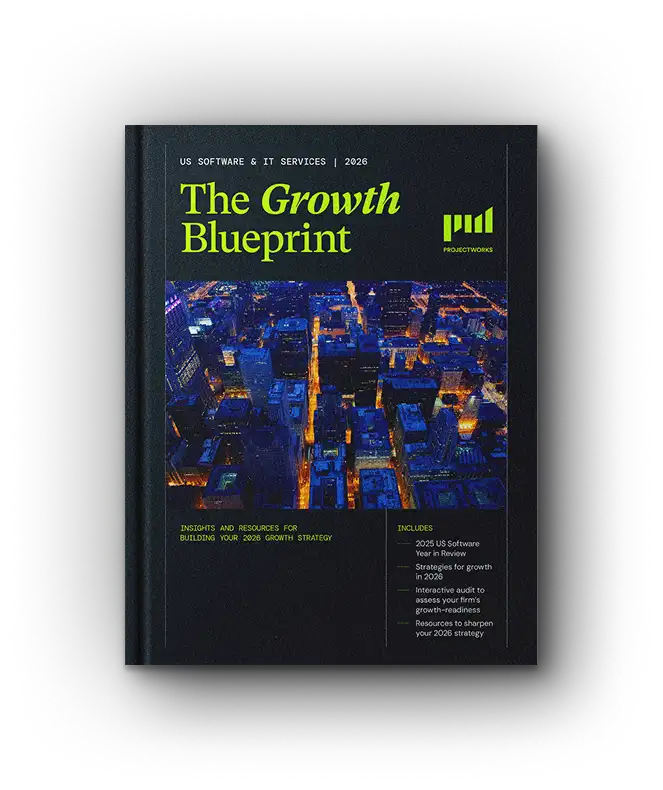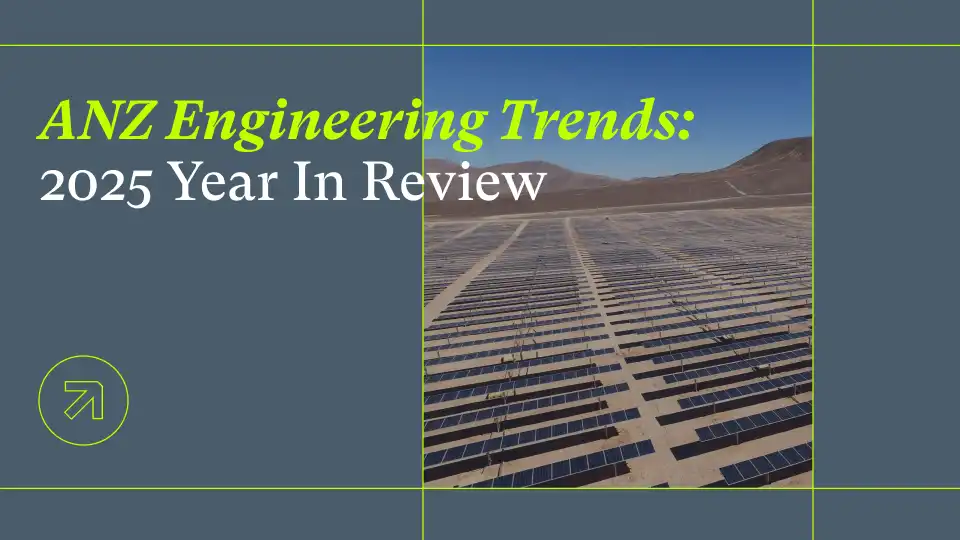SHIFT Conference: 2026 Predictions for Software Consulting

Projectworks hosted its first virtual conference, SHIFT, for high growth US software consulting firms looking to think strategically about how they integrate AI into their internal systems, inspire culture, and standing out in 2026. Below you can catch the replay’s and key predictions from software consulting leaders.
State of Software Consulting in 2026
If you’re a software consulting leader building your 2026 strategy, you’re likely feeling the pressure from all sides. Clients expect more for less. The gap between A-players and everyone else is widening. Delivery leaders are being asked to sell strategically, not just execute. And the AI landscape is loud, crowded, and confusing - with every tool claiming to transform productivity. So where do you begin?
Mark Orttung, CEO of Projectworks, discusses why we are in a once-in-a-decade opportunity to move up the value chain.
Clients will increasingly look to consulting partners for strategic guidance, org redesign, and long term transformation... not just execution. Firms who invest early in understanding which AI capabilities actually create value will win disproportionate mindshare and wallet share.
1. Uncertainty is at an historic high; and that’s good news for consulting.
Mark highlighted the World Uncertainty Index, which is spiking across every region. Geopolitics, AI disruption, shifting budgets, and election cycles are creating unprecedented volatility. But in consulting, uncertainty drives demand, because clients have less clarity than ever before.
2. Leaders don’t have the time or muscle to evaluate and apply AI; they need firms who can.
Most enterprises are overwhelmed by the pace of AI. They don’t know what tools matter, how to evaluate them, or how to translate them into business value. Firms that deeply understand client context and new AI capabilities will become indispensable.
3.Organizational change is exponentially harder from the inside.
Even strong enterprises struggle to transform themselves. The need for external advisors to redesign org structures, processes, and operating models is increasing, not shrinking.
Agentic AI & Building the Future Consulting Firm
Andy Lin, CEO of Provoke Solutions on Agentic AI: What’s Hype, What’s Real, and What Leaders Must Do Now.
Andy shared his firsthand experience building agentic AI internally and for clients, and what many firms are getting wrong. Gartner reports that out of 3,000 firms claiming agentic AI capabilities, only 130 could actually prove sufficiency. Leaders must shift from experimentation to intentional design, and invest where it creates real leverage.
1. GenAI is not just another tech wave; it fundamentally changes the services business model
Andy compares prior disruptions (cloud, agile, project→product) and stresses: this one is qualitatively different. AI agents introduce real intelligence, context-handling, and adaptability — enabling automation of work that traditionally required human judgment.
2. Services firms must shift from selling hours to selling outcomes, and fast.
Clients will increasingly pay for value creation (cost savings, revenue lift), not time. This requires productizing services, building scalable IP/accelerators, and delivering in 40–60% of the old timelines. Firms who don’t evolve will lose to those who do.
3.The entire talent model must be redesigned.
Leaders must:
- Equip A-players with AI to 10× their impact
- Elevate B-players or make hard decisions
- Thoughtfully protect junior work so the next generation can develop — even when agents could do that work
- This isn’t optional. It determines whether today’s teams can become tomorrow’s leaders.
How Software Consulting Firms Will Win in 2026
A new category is emerging: Services-as-Software (SxS). HFS predicts a $1.5 trillion market as services and products converge. This will fundamentally change how consulting firms package, price, and differentiate.
The firms who win will:
- Build proprietary, defensible IP (not “accelerators anyone can copy in a week”)
- Use AI to shrink hours and compress timelines, while maintaining margins
- Become strategic advisors who guide clients into the new model
- Show up with POV, frameworks, governance, and safety guardrails
Your business model, workforce structure, and GTM must evolve, not in 5 years, but now.
Culture is the Foundation of Change
Meghan Lockwood Rexer, GTM Leader and Co-Founder at CoreX, on building a resilient, inspired, and AI- ready organization
As AI accelerates change across delivery, talent, and client expectations, the differentiator that remains uniquely human is culture. Meghan discussed that in 2026, culture can't be a second hand thought, it’s the core operating system that determines whether your people can adapt, lead, and thrive through the shift.
1. Culture needs to become a strategic asset
In a world where AI, IP, and tooling are becoming commodities, culture becomes a real differentiator. It must be built intentionally into strategy, incentives, hiring, and leadership behavior, and built into a repeatable rhythm that is discussed regularly. Firms with high eSAT consistently outperform in growth and profitability.
2. Your teams are navigating stacked disruption — tech, social, and market.
It’s not just AI.
- Tech: agentic AI and data are changing how consulting is done.
- Social: seniors are aging out, pandemic-era grads are stepping into decision roles with very different norms, and remote work has rewired behavior and connection.
- Market: investors are more conservative, risk tolerance is down, price pressure is up, and clients want smaller, faster, outcome-based engagements.
3. In the age of AI, your culture must protect, enable, and grow your people.
Meghan’s “AI-era hierarchy of needs” outlines what teams require:
- Protect: Stability, thoughtful hiring, sustainable business models, clarity on when to use contractors vs. FTEs.
- Enable: Transparency, clear direction, and time/space to learn and experiment with AI tools.
- Grow & Inspire: Redefined talent profiles (learning capacity > legacy expertise), new leadership expectations, and an environment of trust and development.
How to Actually Shift Culture in 2026
- You must treat culture like a product line. Design it, test it, measure it (eSAT, retention, performance), and iterate with intent.
- Talent and leadership are your real AI strategy. Training, hackathons, experimentation time, and psychological safety are not perks... they’re the engine of your AI adoption and differentiation.
- Retention is a financial strategy. Replacing talent is expensive. Keeping the people who want to go on the journey with you (and giving them a reason to stay) is one of the highest-ROI moves you can make.
- Planning cycles must become more agile and more human. Quarterly or semi-annual reality checks: where’s the market, what’s happening to clients, how are teams feeling, and what needs to change culturally and operationally?
Consulting Firm GTM & Differentiation in an Ever-Crowded Market
Mark Orttung, CEO of Projectworks, on how firms stand out when 1,200 new competitors appear every month
With over 1,200 new IT and software consulting firms launching monthly in the US, standing out is no longer about claiming differentiation, it’s about proving it. Mark makes the case that in 2026, growth comes from clarity, timing, and GTM execution rooted in practitioner credibility.
1. Differentiation = Audience × Problem × Unique Offering
AI doesn’t change the fundamentals.To differentiate, you must be explicit about: Who your audience is; What painful, mission-critical problem you solve; How your offering is uniquely suited to solve it
AI is an accelerant — not a substitute — for clarity
2. Timing on the adoption curve determines your value.
Mark brings in the technology adoption curve (innovators → early adopters → majority → laggards) and stresses: boutique firms must live in the innovator/early adopter zones. Once an offering hits early majority, the big firms enter, start buying boutiques, and the market commoditizes. At that point, you either: sell, or innovate again to move to a new curve.
3. Your GTM lives or dies with practitioner-sellers.
Breakthrough offerings don’t sell themselves. You need deep practitioners who can sell:
- People who have “done the work” (PMs, UX, engineers, etc.)
- Who can reframe client asks (“Can I get 3 engineers?” → “You’ll get better outcomes with a product pod.”)
- Who give value in every interaction (mini-consulting, education, reframing).
- They are rare, but they are the backbone of a differentiated GTM
How to Reinvent Your Consulting Firm in 2026
You're competing in a sea of sameness
With more than 1,200 new software and IT services firms launching every month in the U.S., “we’re different” has lost all meaning. Differentiation requires precision. Leaders need a repeatable way to define who they serve, the specific problem they solve, and the offering they bring to market that is both defensible and aligned to where the adoption curve is heading next. Without that clarity, even strong firms blend into an increasingly crowded landscape.
You need an “arc strategy” for reinvention
- Inner arc: what you do today
- Middle arc: what you’re doing in a few places (proven but not scaled)
- Outer arc: the aspirational offering you want to be known for
Each year, you purposely move work from inner → middle → outer, then define a new outer arc. That’s how you systematically reinvent.
Revenue org = product design challenge.
The most effective revenue model:
- Compensates senior practitioner-sellers on revenue/margin/growth (quota-like, not just “nice bonus”)
- Uses bonuses/spiffs for those one layer down to encourage opportunity finding
- Forces the whole GTM motion to align with what’s good for the firm, not just “closing deals”
Consulting Firm Leadership Panel
Mark Orttung, CEO of Projectworks / Allen Debes, CEO Koniag Capital / Megan Lockwood Rexer Co-Founder CoreX
The expert panel brought together perspectives from consulting, GTM, and private equity to explore how AI, market uncertainty, and shifting client expectations will reshape consulting firms in 2026. They surfaced real examples of where AI backfires, what investors look for in AI-ready firms, and how to preserve culture and talent in a time of anxiety. The session closed with powerful, specific advice for leaders planning their 2026 strategies.
Practical guidance on how to future-proof a consulting firm in 2026:
- Investors want proof points, not AI buzzwords: real case studies, real savings, real efficiency gains
- The bar for acquisitions has changed: profitable firms with strong culture, clean financials, and AI-enabled processes command better multiples
- Data governance will make or break AI adoption: especially in regulated industries
- Talent development is a risk factor: junior talent still needs “real work” or you risk losing your next generation of leaders
- Clients are cautious but ready: they’ll invest when they see tangible business outcomes, not pilots or experiments
- Organic sales engines matter more than ever: “revenue fixes a lot of problems”
Curious to Learn More?
You can check out our 2026 US Software Consulting predictions HERE

Related Articles

US Software & IT Consulting Trends: 2025 Year In Review
In a year shaped by AI, Software Services Firms and IT Consultancies across the United States are in a widespread reinvention moment. In this guide we break down how firms are navigating the shift, and what strategies are fuelling growth for small and mid sized firms.

2025 AU Architecture Growth Trends: A Year In Review
Across Australian Architects in 2025, the brief kept getting wider while timelines stayed tight. Clients asked for cooler streets, better shade and movement, water capture and reuse, clear Country pathways, early biodiversity checks and build-ability in view. The studios that grew recognised the pressure early, set clearer scope lines and ran a calmer delivery engine that made decisions weekly instead of monthly.

2025 In Review: The Trends Shaping AU & NZ Engineering Firm Growth
In 2025 for the Engineering Sector down under, pipeline was the conversation irrespective of what side of the ditch your firm sat on. In Australia the pipeline grew quickly across energy, transport, water and social infrastructure. However, turning that momentum into consistent, profitable delivery was still hard for many firms. In New Zealand the public pipeline only became visible toward the end of the year. It was a tougher run, and leaders had to think differently about growth. The firms that moved ahead in both markets built a high performance delivery engine and ran it with calm discipline, thanks to visibility of all key project and business profitability metrics.